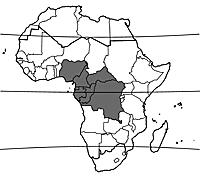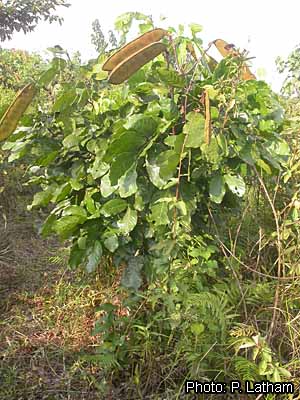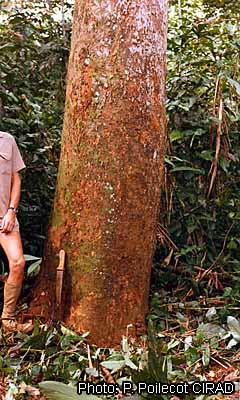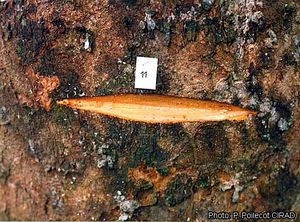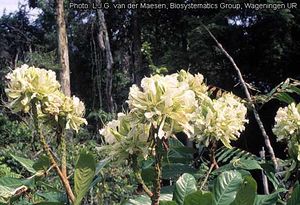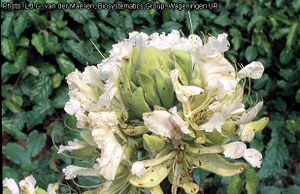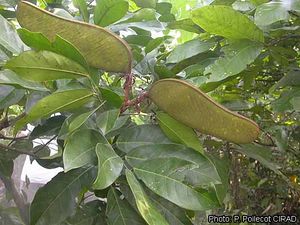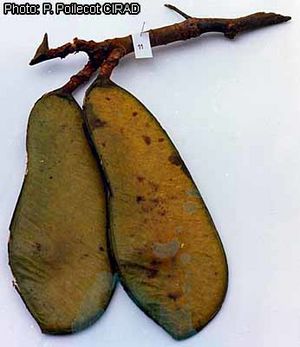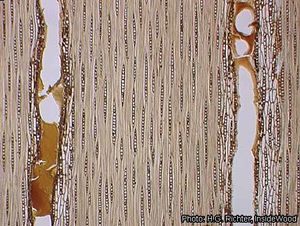Berlinia bracteosa (PROTA)
Introduction |
| General importance | |
| Geographic coverage Africa | |
| Geographic coverage World | |
| Medicinal | |
| Timber | |
| Fuel | |
| Ornamental | |
| Fibre | |
Berlinia bracteosa Benth.
- Protologue: Trans. Linn. Soc. London 25: 309 (1866).
- Family: Caesalpiniaceae (Leguminosae - Caesalpinioideae)
Synonyms
- Macroberlinia bracteosa (Benth.) Hauman (1952).
Origin and geographic distribution
Berlinia bracteosa occurs from south-eastern Nigeria east to the Central African Republic and western DR Congo, and south to Cabinda (Angola).
Uses
The wood, often traded together with other Berlinia spp. as ‘ebiara’, is commonly used for construction, flooring, joinery, interior trim, panelling, furniture, vehicle bodies, agricultural implements, railway sleepers, draining boards and turnery. It is suitable for boat building, veneer, plywood and pulpwood. It is also used as firewood.
In traditional medicine, bark decoctions are used as purgative and to treat oedema, jaundice, toothache and caries. In Central Africa they are administered as an enema to treat diarrhoea and vomiting in children. Berlinia bracteosa is occasionally planted as ornamental village shade tree.
Production and international trade
The wood of Berlinia bracteosa and other Berlinia spp. is currently traded in small amounts only on the international market. In Gabon the export of ‘ebiara’ (Berlinia spp.) logs increased from 200 m³ in 1991 to 6400 m³ in 1999 and to 12,200 m³ in 2005. The export from Cameroon was 500 m³ in 1998, but only 15 m³ in 1999.
Properties
The heartwood is pinkish brown to reddish brown, often with darker streaks, and distinctly demarcated from the up to 10 cm wide, greyish white or pinkish sapwood. The grain is straight to slightly interlocked, texture medium to coarse. The wood has a distinct odour when freshly cut, and gum ducts are often present.
The wood is medium-weight, with a density of 610–720 kg/m³ at 12% moisture content. It air dries slowly with a slight risk of distortion. The rates of shrinkage are moderate, from green to oven dry about 2.8% radial and 7.4% tangential. Quarter-sawing of logs before drying is recommended. Once dry, the wood is stable in service.
At 12% moisture content, the modulus of rupture is 95–159 N/mm², modulus of elasticity 8820 N/mm², compression parallel to grain 48–73 N/mm², shear 8–12 N/mm², cleavage 11–16 N/mm, Janka side hardness 6310 N, Janka end hardness 7645 N and Chalais-Meudon side hardness 2.5–4.6.
The wood generally works and saws fairly easily with ordinary hand and machine tools. The blunting effect on saw teeth and cutting edges is moderate. The wood surfaces take an excellent polish, but picking up of interlocked grain may occur in planing. The wood holds nails and screws well, but pre-boring is needed. The gluing, slicing, peeling and bending properties are all satisfactory. The heartwood is durable. It is fairly resistant to fungi, dry wood borers and termites. The heartwood is resistant to impregnation with preservatives, but the sapwood is permeable.
Adulterations and substitutes
The wood of Berlinia bracteosa closely resembles that of Berlinia confusa Hoyle and has similar uses. The wood of these two species is often mixed in trade under the name ‘ebiara’.
Description
- Small to medium-sized tree up to 30(–35) m tall; bole usually short, branchless for up to 15 m, often irregular, up to 100 cm in diameter, often with low buttresses, sometimes slightly fluted at base; bark surface smooth to scaly, greyish to yellowish, inner bark fibrous, creamy to pale brown, strongly scented; crown spherical, dense; twigs angular, glabrous.
- Leaves alternate, paripinnately compound with (3–)4–5(–6) pairs of leaflets; stipules large, silvery hairy, caducous; petiole 2–7 cm long, rachis up to 30 cm long; petiolules stout, 0.5–1.5 cm long; leaflets opposite or nearly so, oblong-elliptical to oblong-obovate, 10–28(–44) cm × 4–9(–12.5) cm, obtuse to cuneate at base, short-acuminate at apex, leathery, minutely hairy below, pinnately veined with 10–15 pairs of lateral veins.
- Inflorescence a solitary stout terminal raceme up to 30 cm long, densely golden brown short-hairy, many-flowered; bracts 5–10 cm long.
- Flowers bisexual, zygomorphic, 5-merous, scented, with 2 bracteoles up to 7.5 cm × 2 cm at base; pedicel 1–3 cm long; hypanthium c. 1 cm long, nearly glabrous; sepals linear, 2.5–4 cm long; petals free, 5–9 cm long, 1 much broader than other 4, with long claw at base, 2-lobed at apex, white; stamens 10, 4–7.5 cm long, 9 fused at base, 1 free; ovary superior, stiped, densely short-hairy, style slender, about as long as stamens.
- Fruit a large, woody, oblong, flattened pod up to 40 cm × 10 cm, with stipe c. 2 cm long, glabrous, slightly shiny brownish to black, with indistinct diagonal veins, dehiscing with 2 valves, c. 4-seeded.
- Seeds flat, rounded, c. 6 cm in diameter.
- Seedling with epigeal germination; hypocotyl very short; cotyledons thick, dark green, spreading just above ground level.
Other botanical information
Berlinia comprises about 20 species and is confined to tropical Africa with nearly all species occurring in West and Central Africa. Many species closely resemble each other, and identification may be problematic. Berlinia bracteosa belongs to section Macroberlinia, characterized by petals of nearly similar length and large bracts.
Berlinia occidentalis
Berlinia occidentalis Keay also belongs in this section. It is a small to medium-sized tree up to 25(–40) m tall with often irregular bole up to 80 cm in diameter, and occurs from Sierra Leone to Ghana. The wood is used for house construction, joinery and furniture. The bark is used in traditional medicine in Côte d’Ivoire to treat fever and haematuria, and as a tonic. Berlinia occidentalis is included in the IUCN Red List as vulnerable.
Anatomy
Wood-anatomical description (IAWA hardwood codes):
- Growth rings: 1: growth ring boundaries distinct; (2: growth ring boundaries indistinct or absent).
- Vessels: 5: wood diffuse-porous; 13: simple perforation plates; 22: intervessel pits alternate; 23: shape of alternate pits polygonal; 26: intervessel pits medium (7–10 μm); 29: vestured pits; 30: vessel-ray pits with distinct borders; similar to intervessel pits in size and shape throughout the ray cell; (42: mean tangential diameter of vessel lumina 100–200 μm); 43: mean tangential diameter of vessel lumina ≥ 200 μm; 46: ≤ 5 vessels per square millimetre; (47: 5–20 vessels per square millimetre); 58: gums and other deposits in heartwood vessels.
- Tracheids and fibres: 61: fibres with simple to minutely bordered pits; 66: non-septate fibres present; 69: fibres thin- to thick-walled.
- Axial parenchyma: 80: axial parenchyma aliform; 81: axial parenchyma lozenge-aliform; 82: axial parenchyma winged-aliform; 83: axial parenchyma confluent; 89: axial parenchyma in marginal or in seemingly marginal bands; (91: two cells per parenchyma strand); 92: four (3–4) cells per parenchyma strand.
- Rays: (96: rays exclusively uniseriate); 97: ray width 1–3 cells; 104: all ray cells procumbent; 106: body ray cells procumbent with one row of upright and/or square marginal cells; 115: 4–12 rays per mm.
- Secretory elements and cambial variants: 131: intercellular canals of traumatic origin.
- Mineral inclusions: 136: prismatic crystals present; 142: prismatic crystals in chambered axial parenchyma cells.
Growth and development
In Congo the annual growth rate of young trees has been reported to be less than 1 m. In Gabon leaves fall in May–July and subsequently vivid coppery-red new foliage develops. The young leaves, flowers and seeds are eaten by monkeys such as colobus. The presence of ectomycorrhizae has been demonstrated for the roots.
Ecology
Berlinia bracteosa grows in moist forest types, and is particularly characteristic of lowland evergreen forest, where it may also occur in secondary formations. It is often found along rivers, and occasionally occurs in gallery forest in savanna areas.
Propagation and planting
The germination rate of seeds has been recorded to be over 75%.
Management
Berlinia bracteosa occurs locally frequently, e.g. in western Gabon, where the average volume of bole wood is 1.5 m³/ha.
Harvesting
In Gabon the minimum bole diameter for harvesting has been set at 50 cm.
Yield
A tree with a bole of 12 m long and 70 cm in diameter yielded 2.8 m³ of wood.
Handling after harvest
The often poor shape of the bole and the thick sapwood frequently cause much waste in sawing operations.
Genetic resources
Berlinia bracteosa is fairly widespread and there are no indications of current overexploitation in its range of distribution. It is therefore not threatened by genetic erosion.
Prospects
Little information is available on Berlinia bracteosa, especially concerning its growth rates, propagation and planting and suitable management measures. Research is needed to be able to determine possibilities for larger-scale commercial exploitation on a sustainable basis. However, the often poor shape of the bole is a serious drawback, which might be overcome by selecting superior tree types and developing proper methods of vegetative propagation.
Major references
- ATIBT (Association Technique Internationale des Bois Tropicaux), 1986. Tropical timber atlas: Part 1 – Africa. ATIBT, Paris, France. 208 pp.
- Aubréville, A., 1970. Légumineuses - Césalpinioidées (Leguminosae - Caesalpinioideae). Flore du Cameroun. Volume 9. Muséum National d’Histoire Naturelle, Paris, France. 339 pp.
- Bolza, E. & Keating, W.G., 1972. African timbers: the properties, uses and characteristics of 700 species. Division of Building Research, CSIRO, Melbourne, Australia. 710 pp.
- Christy, P., Jaffré, R., Ntougou, O. & Wilks, C., 2003. La forêt et la filière bois au Gabon. Projet Aménagement Forestier et Environnement, Libreville, Gabon. 389 pp.
- CIRAD Forestry Department, 2009. Ebiara. [Internet] Tropix 6.0. http://tropix.cirad.fr/ africa/ebiara.pdf. February 2010.
- de Saint-Aubin, G., 1963. La forêt du Gabon. Publication No 21 du Centre Technique Forestier Tropical, Nogent-sur-Marne, France. 208 pp.
- Keay, R.W.J., Onochie, C.F.A. & Stanfield, D.P., 1964. Nigerian trees. Federal Department of Forest Research, Ibadan, Nigeria. 495 pp.
- Mackinder, B.A. & Harris, D.J., 2006. A synopsis of the genus Berlinia (Leguminosae - Caesalpinioideae). Edinburgh Journal of Botany 63(2&3): 161–182.
- Takahashi, A., 1978. Compilation of data on the mechanical properties of foreign woods (part 3) Africa. Shimane University, Matsue, Japan. 248 pp.
- Vivien, J. & Faure, J.J., 1985. Arbres des forêts denses d’Afrique Centrale. Agence de Coopération Culturelle et Technique, Paris, France. 565 pp.
Other references
- Aubréville, A., 1968. Légumineuses - Caesalpinioidées (Leguminosae - Caesalpinioideae). Flore du Gabon. Volume 15. Muséum National d’Histoire Naturelle, Paris, France. 362 pp.
- Bibani, M.R., Jonkers, W.B.J. & Essama, J.E., 1986. Phénologie de 86 essences productrices de bois d’oeuvre de la forêt dense humide sempervirente du Sud-Cameroun - Résultats préliminaires. Séminaire FORAFRI de Libreville - Session 2: connaissance de l’écosystème. 16 pp.
- Burkill, H.M., 1995. The useful plants of West Tropical Africa. 2nd Edition. Volume 3, Families J–L. Royal Botanic Gardens, Kew, Richmond, United Kingdom. 857 pp.
- Chuyong, G.B., Newbery, D.M. & Songwe, N.C., 2002. Litter breakdown and mineralization in a central African rain forest dominated by ectomycorrhizal trees. Biogeochemistry 61(1): 73–94.
- Holmgren, M., Poorter, L., Siepel, A., Bongers, F., Buitelaar, M., Chatelain, C., Gautier, L., Hawthorne, W.D., Helmink, A.T.F., Jongkind, C.C.H., Os-Breijer, H.J., Wieringa, J.J. & van Zoest, A.R., 2004. Ecological profiles of rare and endemic species. In: Poorter, L., Bongers, F., Kouamé, F.N’. & Hawthorne, W.D. (Editors). Biodiversity of West African forests. An ecological atlas of woody plant species. CAB International, Wallingford, United Kingdom. pp. 101–389.
- Maisonneuve, J.F. & Manfredini, M.L., 1988. Ebiara. Les bois du Gabon. Département de Sciences Naturelles, Institut Pédagogique National, Ministère de l’Education Nationale, Libreville, Gabon. pp. 26–27.
- Neuwinger, H.D., 2000. African traditional medicine: a dictionary of plant use and applications. Medpharm Scientific, Stuttgart, Germany. 589 pp.
- Raponda-Walker, A. & Sillans, R., 1961. Les plantes utiles du Gabon. Paul Lechevalier, Paris, France. 614 pp.
- Sallenave, P., 1955. Propriétés physiques et mécaniques des bois tropicaux de l’Union française. Centre Technique Forestier Tropical, Nogent sur Marne, France. 129 pp.
- Sallenave, P., 1964. Propriétés physiques et mécaniques des bois tropicaux. Premier supplément. Centre Technique Forestier Tropical, Nogent-sur-Marne, France. 79 pp.
- Tailfer, Y., 1989. La forêt dense d’Afrique centrale. Identification pratique des principaux arbres. Tome 2. CTA, Wageningen, Pays Bas. pp. 465–1271.
- Teillier, L., 1994. Le centre pilote d’afforestation en limba de N’gouha 2. République du Congo. Synthèse des recherches forestières realisées de 1981 à 1994. Ministère des Eaux et Forêts, Mossendjo, Congo. 112 pp.
- White, L. & Abernethy, K., 1997. A guide to the vegetation of the Lopé Reserve, Gabon. 2nd edition. Wildlife Conservation Society, New York, United States. 224 pp.
- Wilczek, R., Léonard, J., Hauman, L., Hoyle, A.C., Steyaert, R., Gilbert, G. & Boutique, R., 1952. Caesalpiniaceae. In: Robyns, W., Staner, P., Demaret, F., Germain, R., Gilbert, G., Hauman, L., Homès, M., Jurion, F., Lebrun, J., Vanden Abeele, M. & Boutique, R. (Editors). Flore du Congo belge et du Ruanda-Urundi. Spermatophytes. Volume 3. Institut National pour l’Étude Agronomique du Congo belge, Brussels, Belgium. pp. 234–554.
- Wilks, C. & Issembé, Y., 2000. Les arbres de la Guinée Equatoriale: Guide pratique d’identification: région continentale. Projet CUREF, Bata, Guinée Equatoriale. 546 pp.
Sources of illustration
- Aubréville, A., 1968. Légumineuses - Caesalpinioidées (Leguminosae - Caesalpinioideae). Flore du Gabon. Volume 15. Muséum National d’Histoire Naturelle, Paris, France. 362 pp.
- Wilks, C. & Issembé, Y., 2000. Les arbres de la Guinée Equatoriale: Guide pratique d’identification: région continentale. Projet CUREF, Bata, Guinée Equatoriale. 546 pp.
Author(s)
- R.B. Jiofack Tafokou, Ecologic Museum of Cameroon, P.O. Box 8038, Yaoundé, Cameroon
Correct citation of this article
Jiofack Tafokou, R.B., 2011. Berlinia bracteosa Benth. [Internet] Record from PROTA4U. Lemmens, R.H.M.J., Louppe, D. & Oteng-Amoako, A.A. (Editors). PROTA (Plant Resources of Tropical Africa / Ressources végétales de l’Afrique tropicale), Wageningen, Netherlands. <http://www.prota4u.org/search.asp>.
Accessed 2 June 2025.
- See the Prota4U database.

